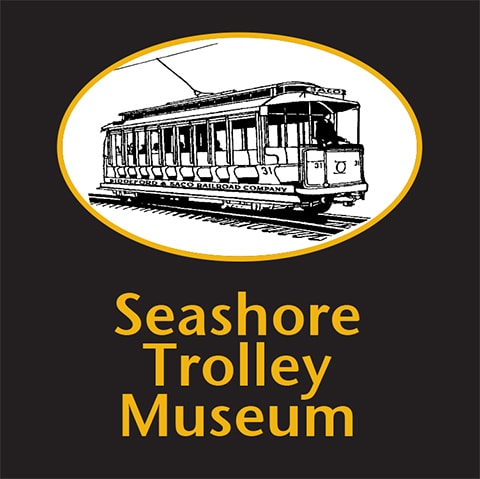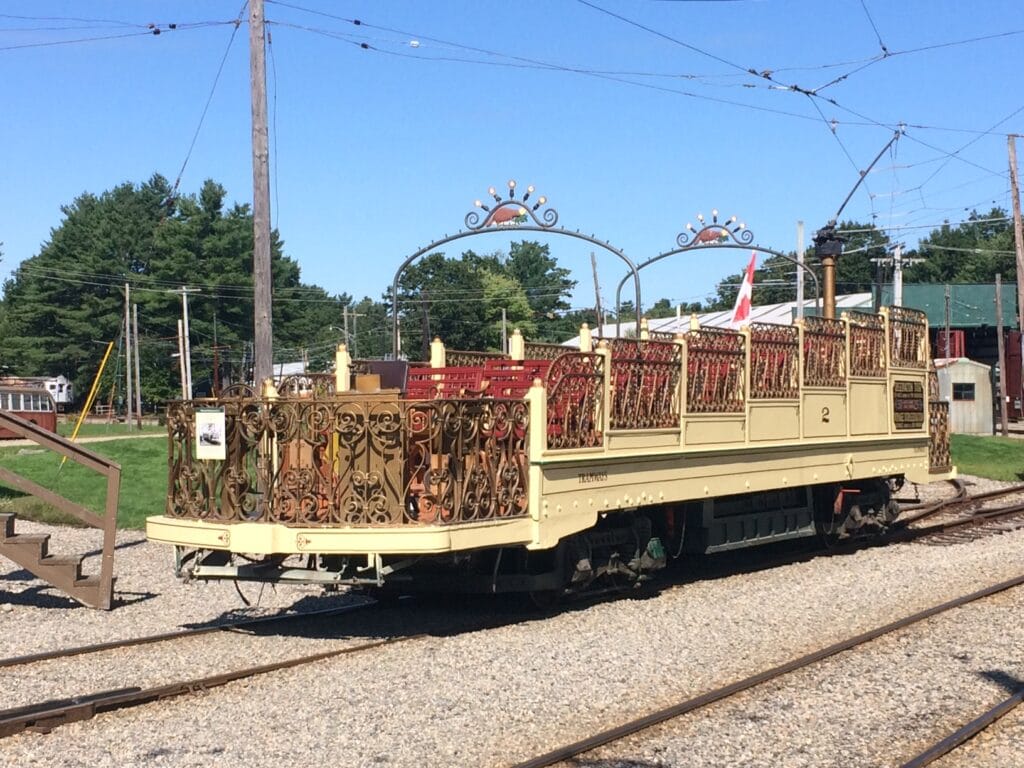On Tuesday, December 3rd, the world is celebrating #GivingTuesday, a global generosity movement and day of giving. Seashore Trolley Museum is raising funds on GivingTuesday to support rebuilding the trucks of the Montreal Tramways Golden Chariot Observation Car #2.
Please support our mission and contribute! We will not be able to operate the Golden Chariot again until we replace the cast iron wheelsets with steel wheels. We have raised $27,616 to date for this work; any dollar amount is appreciated to help us get to our $100,000 goal for this project!
Visit our Facebook and Instagram pages and/or check your email on December 3rd and share our #GivingTuesday donation posts with your network to help us raise funds to support our mission and this work. To support the Golden Chariot through our website, designate your gift to Fund 765 at https://trolleymuseum.org/support/donate
The Golden Chariot’s Current Condition
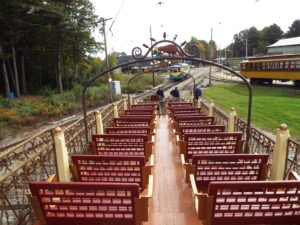 The Golden Chariot was part of Seashore’s special operating fleet as recently as 2019, frequently operating for our members and the general public during our special events, most notably during Christmas Prelude. In 2019, the car operated once each day on most weekdays during the season, which proved to be quite popular, and we planned to operate the Golden Chariot as often in 2020. During the Golden Chariot’s pre-season two-week inspection in spring 2020, significant wear on the truck bolster chafe plates was discovered, taking the car off line. A successful fundraising campaign was held on 2020’s #GivingTuesday that December, and our restoration team began working to make repairs in 2021.
The Golden Chariot was part of Seashore’s special operating fleet as recently as 2019, frequently operating for our members and the general public during our special events, most notably during Christmas Prelude. In 2019, the car operated once each day on most weekdays during the season, which proved to be quite popular, and we planned to operate the Golden Chariot as often in 2020. During the Golden Chariot’s pre-season two-week inspection in spring 2020, significant wear on the truck bolster chafe plates was discovered, taking the car off line. A successful fundraising campaign was held on 2020’s #GivingTuesday that December, and our restoration team began working to make repairs in 2021.
However, to our disappointment, additional issues with the Golden Chariot’s trucks were discovered. The car’s cast iron wheelsets unfortunately are at the end of their service life and need to be replaced with steel wheels before the Golden Chariot can return to service. We’re looking to contract with a skilled and expert supplier who can do this type of work and address any additional issues that arise during the rebuilding process.
By completing this work now, we are ensuring the car’s future. The Golden Chariot will be able to operate more often with these upgrades. The investment we are making in rebuilding the car’s trucks will keep the car in a safe operating condition for decades to come.
About Montreal Tramways Observation Car No. 2
Montreal No. 2, known in Montreal as the “Golden Chariot,” was built in 1906 by the Montreal Street Railway. The car operated through 1958 and was operated by the Montreal Street Railway, Montreal Tramways, and the Montreal Transportation Commission. The Golden Chariot is one of Seashore’s most popular trolleys, and we have missed being able to operate the car for our members and the general public over the past few seasons.

Montreal 2, in service, early 1900s. Photo from the Seashore Collection
Operating History: Sightseeing cars were operated in a number of cities in the United States and Canada and came in a variety of shapes and sizes. Montreal Tramways No. 2, however, is a rare type of sightseeing car. Montreal was inspired to build the cars by a tiered car circulating at the 1904 St. Louis World’s Fair attended by company executives. The first of these cars was constructed in the company shops in 1905, and No. 2 car was added the following spring. The observation cars were so successful that two more such cars were eventually constructed in 1924. In 1954, a three-window front windshield was installed on each observation car (this has been removed on No. 2 and stored at Seashore). All four operated sightseeing tours around Montreal until 1957, and were available for charter for another year. The sightseeing cars were considered too iconic to scrap. All four are now preserved, two (Nos. 1 and 3) at Exporail near Montreal, one (No. 4) at the Connecticut Trolley Museum in East Windsor, CT, and No. 2 at Seashore.
No. 2 differs from conventional open cars in that it has no roof and its seats are arranged theater-fashion at progressively higher levels on either side of a center aisle. It is a uni-directional car with controls only at one end. The car features fine iron grillwork on the sides and ends and two brass arches topped with light bulbs and cast metal beavers. There were about a dozen similar cars in a few cities in Canada and the United States. Nos. 1 and 2 are equipped with the iconic and adored beaver arches.
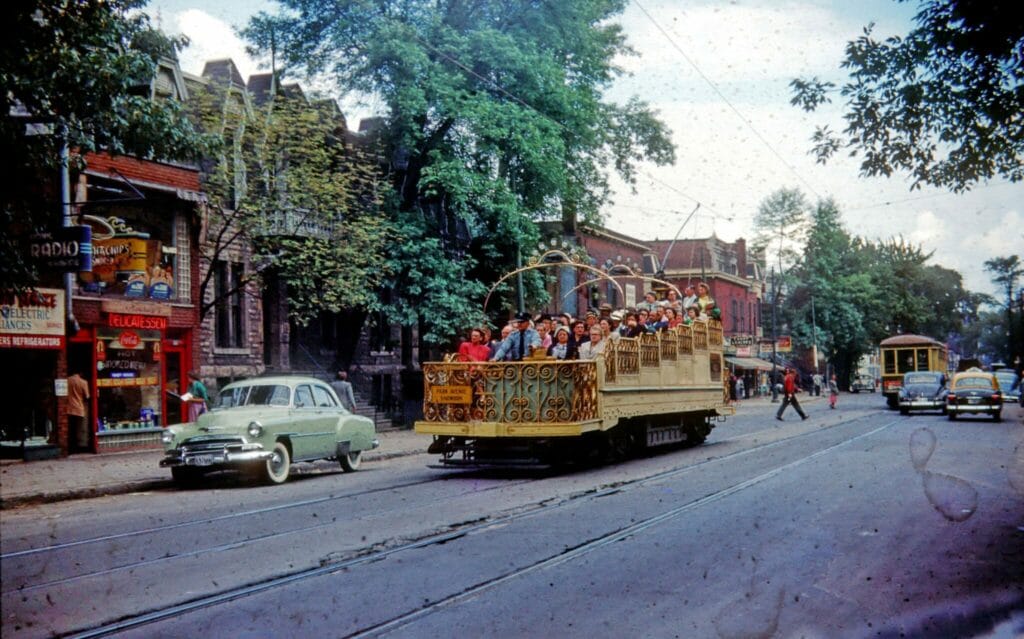
Montreal 2, in service, pre-1954. Photo from the Seashore Collection
The Golden Chariot was acquired in 1963 by Seashore Trolley Museum. The acquisition of No. 2 was sponsored by the Carling Brewing Co., and included a tour of several New England cities and towns. In the 1980s, the museum restored No. 2 under a grant from the U.S. Institute of Museum Services. Complete repainting, along with some mechanical and electrical work was undertaken in 2014, under the primary sponsorship of a generous member.
To support the Golden Chariot through our website, designate your gift to Fund 765 at https://trolleymuseum.org/support/donate
To show our gratitude for your support of our GivingTuesday campaign, we are offering the following donor incentives to those who give today through next Tuesday, December 10, 2024:
Give $25 or more and be entered for a chance to win a $50 Museum Store gift card!
Give $50 or more and be entered for a chance to win all incentives listed above this one, AND the opportunity to operate the model trains on the Maine Central Model Railroad for 60 minutes in 2025!
Give $100 or more and be entered for a chance to win all incentives listed above this one, AND you will also be entered for a chance to win a free Be A Motorman experience during our 2025 season! Learn how to operate one of our regular fleet trolleys with a skilled instructor during your own one-hour class. Also included: Admission for immediate family members, who can ride with you as you operate the trolley! Winners of this incentive must be 18+.
Give $250 or more and be entered for a chance to win all incentives listed above this one, AND you and up to four guests of your choice AUTOMATICALLY WIN a behind-the-scenes, docent-guided tour of Central and Fairview Carhouses, our transit artifact storage carhouses off limits to the general public. This prize also includes the price of museum admission for you and your four guests if you are not already members.
Give $500 or more and be entered for a chance to win all incentives listed above this one, AND Enter for a Chance to Name the Golden Chariot Beavers! Be a part of Seashore History and enter your submission to name the two beavers that adorn the Golden Chariot’s arches for our 2025 season. If we receive more than one submission to name the beavers, our social media followers will help us choose the winning names with a fan vote beginning December 11, 2024. Only “Rated G” names that won’t jeopardize our nonprofit status will be considered (names must be apolitical, secular, etc.). If you donate online, in the comments section simply share your two name submissions.
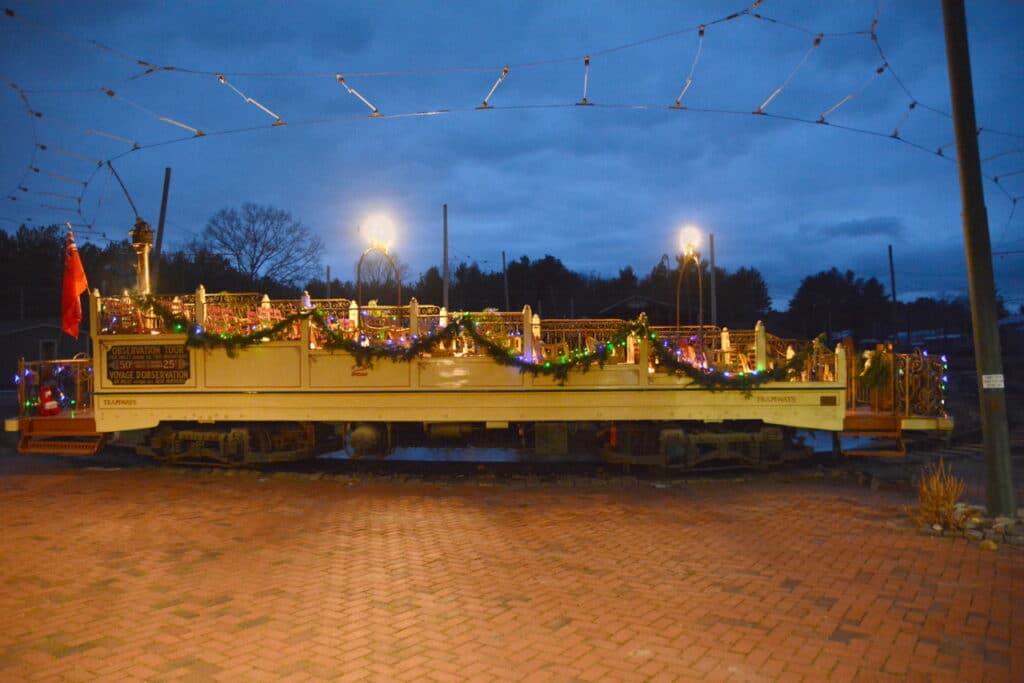
The “Golden Chariot” decked out for Christmas Prelude events, December 2018. Photo by Fred Hessler
